Program for a set of hieroglyphs. This is what a Chinese keyboard looks like
Now that your computer has learned to understand Eastern writing(see previous post), let's start computer calligraphy. After reading this post and trying it out in practice, you will learn write in chinese, directly in hieroglyphs, even without using a special "Chinese keyboard".
Pinyin is used to set hieroglyphs. Pinyin is the Latinized syllables of the Chinese language. Literally from Chinese汉语拼音 - "Recording the sounds of Chinese". Pinyin has an official status and has been used all over the world since the 1980s.
So, move the keyboard to Ch mode (if the third layout interferes, assign the Ch-Ru and Ru-Ch switching to another keyboard shortcut).
We will have a panel (you can "restore the panel" to make it easier to figure it out) like this:
On this moment you can use the buttons:

Fast switching English-Chinese and vice versa. For us, it's not really important.

Punctuation European or Chinese. Commas and periods in Chinese writing have a slightly different style.

Switching from traditional characters to simplified ones and vice versa. Stay simplistic and get to the action.
Let's say we want to type the phrase:
吃一堑,长一智
In pinyin, it would look like this:
chī yī qiàn, zhăng yī zhì
Enter on the keyboard with Latin letters chi , we press not a space and we have a hieroglyph! 吃 , what in this context means " suffer, endure, endure . Similar? Press the spacebar again and go to the next:

We type yi , space. Now wait. While the hieroglyph is active (see the underline below?), press the regular arrow key "to the right" or "to the left". We will open an additional menu offering different spellings. In Chinese, one syllable can sound five, ten, or twenty different characters, just like one character can mean different things and be pronounced differently. And keyboard pinyin also does not take into account tones and, in fact, combines several syllables. Arrow keys " up" And "down" choose the style we need. In our case, 一 - which most often means " one, whole, as soon as" or serves to indicate a brief action .

Searching for hieroglyphs on smartphones is the most convenient and easy way searching for hieroglyphs (compared to searching through paper dictionaries and ). You will need any smartphone based on iOS, Android or Windows phone. For the student Chinese Smartphone can save a lot of time.
Now we need chinese keyboard(which will allow typing)
iPhone
Entering hieroglyphs
You can turn on handwriting hieroglyphs in the main phone settings:
Settings > General > Keyboard > International
Select Chinese Simplified and Handwriting.
Finding the meaning of hieroglyphs
1) Pleco
This is the most important program for the learner of Chinese.
There is also a search for words by pinyin (you type with an English keyboard), and a search by style, and a reader, and a search for hieroglyphs-inscriptions when you hover the camera.
But I note that this program only translates into English language. If your knowledge of English is insufficient, use these programs only to determine the pinyin, and then type the word in the browser in BKRS.
Android
Entering hieroglyphs
1) Install Go keyboard and select: 中文 (手写) . Now we can open the dictionary.
If you have the Pleco program installed, and you do not intend to type text or SMS outside the program, then it is not necessary to install a keyboard, Pleco has the input of hieroglyphs by design.
Finding the meaning of hieroglyphs
1) Pleco
The functionality is the same as on iOS, see above.
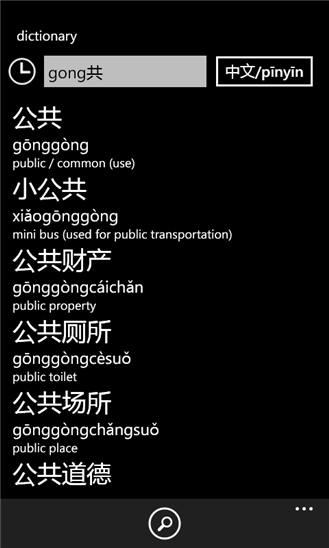
Contains a dictionary and the ability to add words to bookmarks. It also allows you to enter many characters at once (for example, a whole sentence) like an online BKRS dictionary. But the translation is only in English.
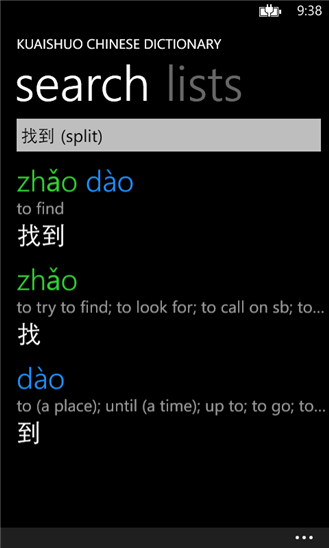
Free English-Chinese and Chinese-English offline dictionary.
To search for a character on any device, you can also use the sites: BKRS. Russian-Chinese, Chinese-Russian dictionary and Chinese-Tools English-Russian, Russian-English dictionary.
If you have already started learning Chinese, then this moment will definitely come. The moment when you need to print this or that hieroglyph and even text in Chinese.
There are several ways to do this. Let's consider one of them.
This is the input of Chinese characters using the program NJstar Word Processor. It is convenient, simple and understandable. The program is a professional tool for entering hieroglyphs and not only for this. It contains many useful tools. And one more important plus, it weighs only 5 Mb.
The program also includes a Chinese-English dictionary, search for the desired characters by radicals and the number of strokes. Input of both simplified and traditional characters. And also the most convenient tool that allows you to show the pronunciation of both a single character and the entire text in Pinyin transcription
Working with the program NJstar Word Processor
After installing the program, we perform some settings for convenience. It is better to move the input panel to the top so that it is always in front of your eyes. To do this, click on this arrow.
First, let's consider, in fact, the main purpose of the program.
Entering Chinese characters with NJstar Word Processor.
The program provides several input systems different ways.
1.
Entering Chinese Characters with "Pinyin" Transcription
Moreover, this can be done in three different ways.
online pinyin
direct input of a character in a document if you know the syllable and its tone. In the list that opens, select the desired hieroglyph.
standard pinyin
standard pinyin, it is enough to know the syllable with which the hieroglyph is pronounced, and only then select the desired hieroglyph from the proposed list. The syllable is typed in the input box automatically. 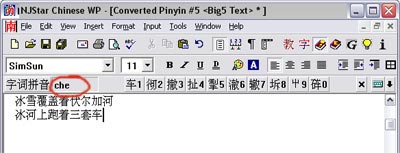
Use these buttons to scroll through the list.

After finding the desired hieroglyph, press the number next to the hieroglyph on the keyboard. The desired character appears in our document.
To clear the input box, press
double pinyin
entering established words using a shortened version of pinyin. That is, you enter part of the syllable of the first hieroglyph, without tone, then enter the second syllable and in the drop-down list you can select a ready-made word written in hieroglyphs. But for fast printing you need to know the abbreviated version of pinyin.
2.
Entering characters using the Chinese phonetic alphabet "Zhuyin"
Hieroglyphs are entered using the Zhuyin phonetic system, of course, you need to know it. 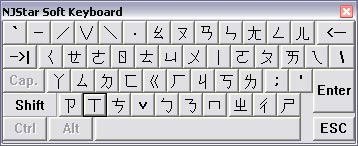
3.
With the help of a digital code assigned to each hieroglyph in big5 and GB encodings
You enter the number-code of the desired hieroglyph using tables with encodings.
Also in the program there are more than 20 methods for entering Chinese characters. But they are less common. 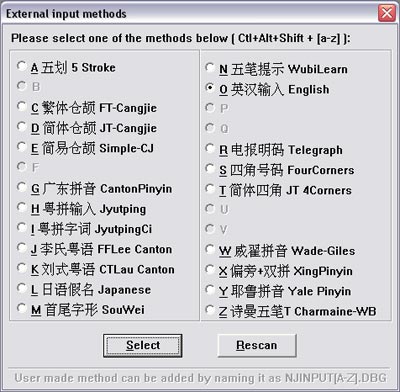 Of these methods, the method of entering hieroglyphs using English is quite convenient. "English" That is, if you know English. You choose this method and by typing in the input box English word you can choose it Chinese translation from the proposed list.
Of these methods, the method of entering hieroglyphs using English is quite convenient. "English" That is, if you know English. You choose this method and by typing in the input box English word you can choose it Chinese translation from the proposed list.
To change the input system, you can use hotkeys or go to the menu and select the desired input method for hieroglyphs.
To insert Russian words, you need to select the menu and choose
To show the transcription of the text, you need to select the text and use the second mouse button to open the context menu. There already select "Convert hanzi to pinyin" 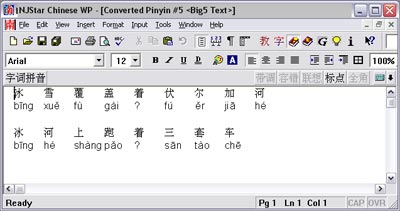
If you want to translate a hieroglyph, just hold the mouse cursor over it for a while and its translation into English will pop up.
To find the desired hieroglyph, you can use the hieroglyph search by radical and number of strokes. To do this, enter the menu again and choose Radical lookup 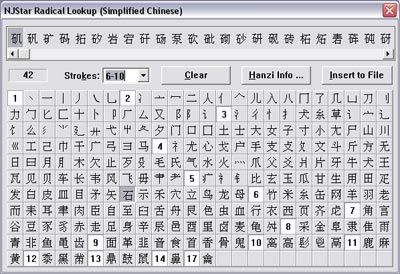
To select simplified characters or traditional characters, go to the menu
The finished document will be easily saved in text format, keeping all your hieroglyphs. In the future, you can open it in Microsoft Word and continue working.
You can download the program under
Today, there are thousands of Internet users in almost every country in the world. There are millions of websites and blogs on the most different languages. For example, there are about 16 million bloggers in China.
Have you ever wondered how the Chinese type on a computer? After all, Chinese writing does not consist of letters, but of hieroglyphs. At the same time, the total number of hieroglyphs exceeds 80 thousand, although most of them are now practically not used. However, for writing contemporary texts you need at least 1500-3000 hieroglyphs!
It is quite difficult to imagine a keyboard with thousands of characters. Surely many people think that the Chinese keyboard looks something like this.
In fact, everything is much more complicated. In China, there are several text input options and there is no single standard keyboard.
Some people use a regular keyboard and special text input programs that can convert the characters they type into written Chinese characters.
Others use special keyboards or enter text using transliteration (phonetic input). In this case, the sound of a certain character is entered using a conventional Latin keyboard. The sign is then recognized using Pinyin, the official romanization system for Chinese.
Users who need to type very fast most often use another input method - kill (Wubi). The special keyboard for kill is similar to the standard QWERTY keyboard, but there are several characters for each button. This is one of the most common input options. The secret is that everything Chinese characters can be "assembled" from the same parts - graphemes. There are about 200 such parts in total. It was they who tried to fit on the keyboard. Here's what it looks like.

Older people who are used to writing by hand often use e-mail.
As you can see, there is no standard input method in China, there are dozens different options, so keyboards can look completely different.
Marketium - positive, inspiration and life hacks
Click Like, →
to get the best
Facebook posts.
The content of this Site, such as the articles, text, graphics, images and other materials posted on this Site ("Content"), is for informational purposes only. No representations or warranties, express or implied, of completeness, accuracy, reliability, suitability or availability, for any purpose, are made with respect to the Content posted on this Site. Any use of the Content is at your own risk. Content should not be considered professional advice for legal, medical, financial, family, risk management or any other professional advice. If you require any specific advice, please consult a licensed or expert in the relevant field. The Publisher is not responsible for any injury or damage to the reader that may result from the reader acting on or using the Content contained on this Site.




